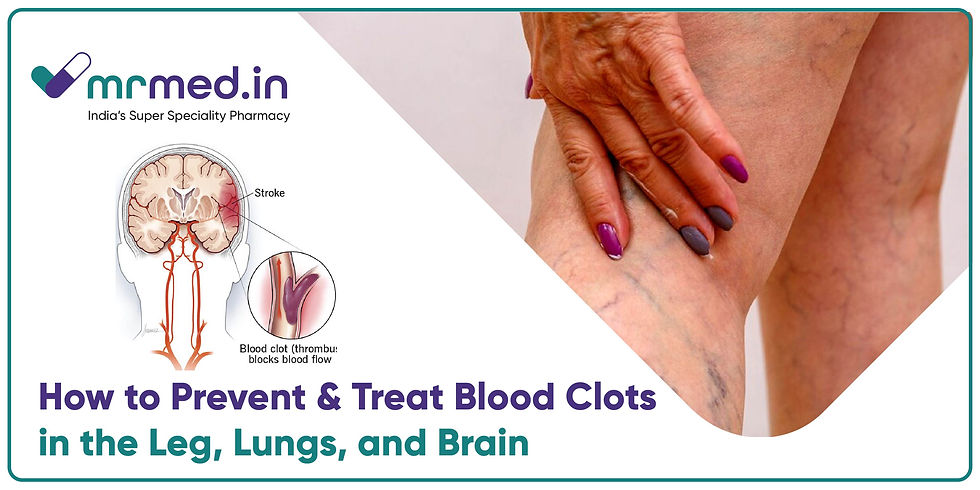Blood Clots in the Leg, Lungs, and Brain: Symptoms & Treatment
- Healthcare Tips

- Mar 21
- 4 min read

You are going about your daily routine, only to suddenly experience unexplained pain in your leg, shortness of breath, or a severe headache. What if these were signs of a blood clot forming in your body? Blood clots may seem harmless at first, but when they block blood flow to vital organs like the lungs or brain, they can become life-threatening.
Blood clot-related conditions, such as Deep Vein Thrombosis (DVT), Pulmonary Embolism (PE), and Stroke, affect millions of people worldwide. But how do you recognise the symptoms, and what can you do to prevent or treat them? Let’s break it down in a simple and easy-to-understand way.
What causes blood clots in the leg, lungs, and brain?
It is a natural process that helps prevent excessive bleeding when you get injured. However, sometimes clots form where they shouldn’t, leading to severe health complications. Some of the major causes are:
Prolonged immobility: Remaining seated for extended periods, like during long flights or bed rest, can slow blood circulation and increase the risk of clot formation.
Heart diseases: Conditions like atrial fibrillation (irregular heartbeat) can cause clots to travel to the brain, and it may cause stroke.
Obesity: Excess body weight puts extra pressure on veins, making clot formation more likely.
Smoking and dehydration: Both can thicken the blood, making it easier for clots to form.
Genetic conditions: Some people have inherited clotting disorders that make them more prone to developing clots.
Now that we know what causes them let’s look at how blood clots affect different parts of the body.
What are the symptoms of a blood clot in the leg?
A blood clot that forms in the deep veins of the leg is called Deep Vein Thrombosis (DVT). If it dislodges and moves to the lungs, it can become a serious health risk. Symptoms of DVT include:
Swelling in one leg (rarely both)
Pain or tenderness that worsens when walking or standing
Warmth and redness over the affected area
Visible veins that appear more prominent than usual
Ignoring these signs can be risky, as DVT can lead to a life-threatening pulmonary embolism.
How do blood clots affect the lungs?
When a blood clot from the leg travels to the lungs, it causes a Pulmonary Embolism (PE). Symptoms include:
Sudden shortness of breath
Chest pain that worsens when breathing deeply
Coughing up blood
Rapid heartbeat and dizziness
PE can lead to severe breathing difficulties and heart complications, making early detection crucial.
What are the signs of a blood clot in the brain?
A blood clot in the brain can result in a stroke, one of the leading causes of disability and death worldwide. Symptoms of a stroke appear suddenly and can be life-threatening. The FAST method helps identify stroke warning signs:
Face drooping: One side of the face may appear uneven or feel numb.
Arm weakness: One arm may feel heavy, weak, or difficult to lift.
Speech difficulty: Speech may become slurred, unclear, or hard to understand.
Time to act fast: Immediate medical help is crucial to prevent serious complications.
Other symptoms may include severe headache, vision loss, and difficulty walking. Seeking urgent treatment can minimise brain damage and improve recovery chances.
How are blood clots treated?
Blood clot treatment focuses on preventing the clot from growing and reducing the risk of future clots. The type of treatment depends on the clot’s location and severity.
Medications:
Blood thinners (anticoagulants): Medicine like Apixaban assist in stopping new clots from developing while preventing existing ones from increasing in size.
Clot-busting drugs (thrombolytics): In severe cases, medications like Stpase Injection are used to dissolve dangerous clots quickly.
Medical procedures:
Catheter-directed thrombolysis: A procedure where a thin tube delivers medication directly to the clot.
Surgical clot removal: Rarely used but necessary in life-threatening situations.
Lifestyle changes:
Regular movement: Avoid sitting for long periods, especially during travel.
Exercise: Walking and leg stretches improve circulation and reduce clot risk.
Hydration: Drinking enough water prevents blood from thickening.
Maintaining a healthy weight: Managing obesity lowers the risk of clot formation.
Can blood clots be prevented?
Absolutely! While some risk factors, like genetics, cannot be changed, many lifestyle habits can help reduce the likelihood of developing dangerous blood clots. Here’s what you can do:
Wear compression stockings: These help prevent DVT, especially after surgery or long flights.
Quit smoking: This lowers your risk of clot-related conditions.
Stay active: If you work a desk job, take short walking breaks every hour.
Monitor heart health: Since heart diseases can lead to clot formation, regular checkups are essential.
Manage chronic conditions: Diabetes, high cholesterol, and high blood pressure all contribute to clot risks, so keeping them under control is key.
Final thoughts
Blood clots in the leg, lungs, and brain are serious health threats that require prompt attention. Recognising the symptoms early and seeking medical help can be life-saving.
With advancements in medicine, tab apigat 2.5 and other treatments have made blood clot management more effective. However, prevention remains the best approach. Staying active, eating healthy, and managing heart health can significantly lower your risk of developing dangerous clots.
If you ever notice signs of a clot, don’t ignore them—your body might be warning you before it’s too late!
Comments